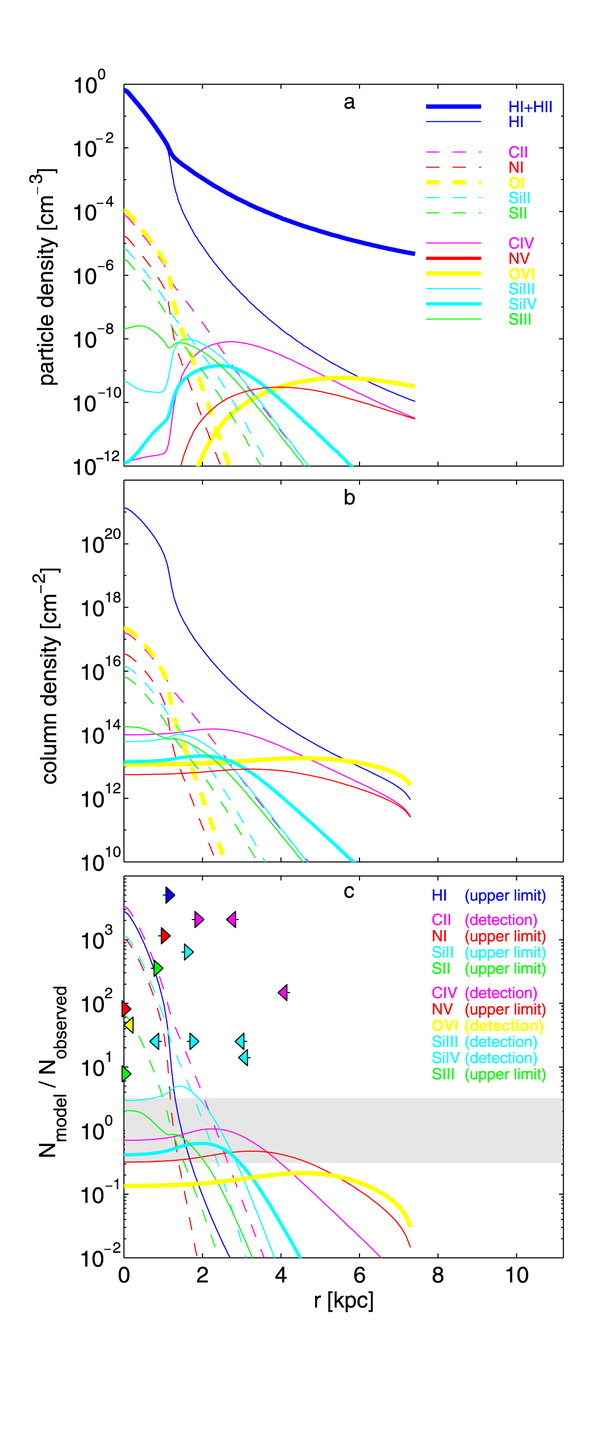Abstract
We present computations of the metals photoionization structures of pressure-supported gas clouds in gravitationally dominant dark matter minihalos in the extended Galactic halo or Local Group environment. We consider low-metallicity (0.1–0.3 ZSun) clouds that are photoionized by the present-day metagalactic radiation field and are also pressure confined by a hot external medium. We study the properties of &Lambda CDM Burkert (and also NFW) minihalos with characteristic circular velocities from 12 to 30 km s-1 (108- 2 x 109 MSun).
We present results for the volume densities and projected column densities of low-ionization metal atoms and ions, C II, N I, O I, Si II, and S II, produced in the neutral cloud cores, and high ions, C IV, N V, O VI, Si III, Si IV, and S III, produced in the ionized shielding envelopes.
We examine the possible relationships between the compact H I high-velocity clouds (CHVCs), dwarf galaxies, and high-velocity ionized C IV absorbers, within the context of photoionized minihalo models for such objects.
As a guide to the observations of the high-velocity C IV absorbers, we focus on the results presented by Sembach et al. and Collins et al. for the C IV HVCs toward the extragalactic sources Mrk 509 and PKS 2155-304.
In pressure-confined (P/k ∼ 50 cm-3 K) minihalo models for the CHVCs the photoionization states are much lower than in the C IV absorbers. However, for lower bounding pressures <~1 cm-3 K, in more massive ∼2 × 109 MSun dwarf galaxy–scale halos, the photoionization states in the outer envelopes resemble those observed in the C IV HVCs. An important exception is O VI, for which our photoionization models underpredict the relative abundances by about an order of magnitude, suggesting that additional processes are at play.
For the cloud size scales expected in median ΛCDM Burkert halos, a gas metallicity of 0.3 ZSun is required to produce absorption-line strengths comparable to those in the C IV HVCs. We argue that fully ionized and starless "dark galaxies" could be detectable in the local universe as UV metal line absorbers with ionization states similar to the C IV absorbers.
Figure: A dwarf-galaxy scale model, with Mvir = 2 × 109 MSun, Mgas = 1.6 × 107 MSun, 0.3 solar metallicity and external bounding pressure of 0.1 cm-3K.
Panel (a) shows the volume densities as a function of the distance from the cloud center, and panel (b) shows the projected column densities.
Panel (c) displays, for each ion, the ratio of the calculated columns to the observed columns in the -300 km s-1 metal ion absorber toward Mrk 509 (Collins et al. 2004).
The legend indicates species with measured columns, upper limits, or lower limits. In the shaded area the calculated and observed values agree to within 0.5 dex. For each of the species, the arrows indicate the range of radii (between the arrowheads) where the model columns are within 0.5 dex of the measured values or limits.
The measured column densities of all species, with the exception of O VI, are consistent with this model for sight lines passing between 2–2.6 kpc from the cloud center. The observed O VI column cannot be reproduced for any line of sight.
